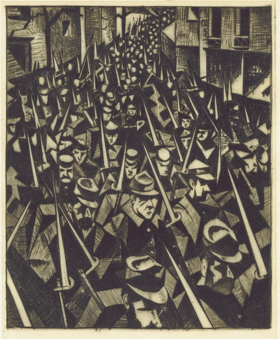British Museum Opens New Display CRW Nevinson: Prints Of War And Peace

The British Museum presents CRW Nevinson: Prints of War and Peace, a new display celebrating a selection of works documenting Nevinson's experiences during the First World War. This free show commemorates the centenary of Nevinson's substantial gift of 25 of his prints to the British Museum in 1918, with a number of works on display for the first time.
Christopher Richard Wayne Nevinson (to give him his full name, though he always preferred to be known by his initials) attended the Slade School of Art from 1909 - 1912. It was a golden generation of artists that were studying there at the time - among his fellow students were: Stanley Spencer, Mark Gertler, Paul Nash and Dora Carrington. On display is a remarkable self-portrait Nevinson executed while a student at the Slade. This striking work echoes the Old Masters drawings that the school's formidable tutor, Henry Tonks, encouraged his students to examine at the British Museum. This will be presented alongside a visitor book from the British Museum's Print Room with both Nevinson and Gertler's signatures in, and both artists were often found working there during these years.
It was the new and exciting style of the Futurists that captured Nevinson's imagination. Once Nevinson experienced for himself the ugly reality of war when he volunteered as an ambulance driver (November 1914 - January 1915) he saw the slaughter that the first mechanised war could deliver. On display are works such as A Dawn, 1914 and Column on the March, which both show massed ranks of French soldiers, devoid of any individuality, tightly packed together marching to their doom as future cannon fodder
Shocked and disgusted by the conditions that the wounded soldiers had to endure, Nevinson vividly conveyed the desolation and horror he encountered in prints such as The Doctor and Twilight. In his autobiography Paint and Prejudice (1937), Nevinson recorded his impressions of 'The Shambles', a disused railway goods yard outside Dunkirk, where wounded French and German soldiers had been abandoned:
'There we found them. They lay on dirty straw, foul with old bandages and filth...It was dark when we arrived. There was a strong smell of gangrene, urine, and French cigarettes, although a spark on the floor would have turned the whole place into a crematorium. Our doctors took charge, and in five minutes I was nurse, water-carrier, stretcher-bearer, driver and interpreter. Gradually the shed was cleansed, disinfected and made habitable, and by working all night we managed to dress most of the patients' wounds.'
This focussed display also includes dynamic urban cityscapes that Nevinson created after the war. From the vertiginous skyscrapers in Looking down into Wall Street and the exquisite Looking through Brooklyn Bridge, New York with the misty Manhattan sky line visible in the background. The febrile atmosphere of the crowd is superbly rendered in the large lithograph Wet Evening, Oxford Street and Nevinson's favourite city, Paris, is affectionately captured in From a Paris Window, 1922 and Place Blanche, 1922.
As critical acclaim for Nevinson's prints reached its height in the late 1920s, he had to give up printmaking for health reasons and died in 1946. As his painting became more conventional, Nevinson's reputation suffered and today he is an almost forgotten artist. The stark black and white images of the First World War presented in powerful display showcase Nevinson as a one of the finest modernist printmakers of his generation.
CRW Nevinson: Prints of War and Peace
Tuesday 24 July - 13 September 2018
Room 90a
Comments

Videos

